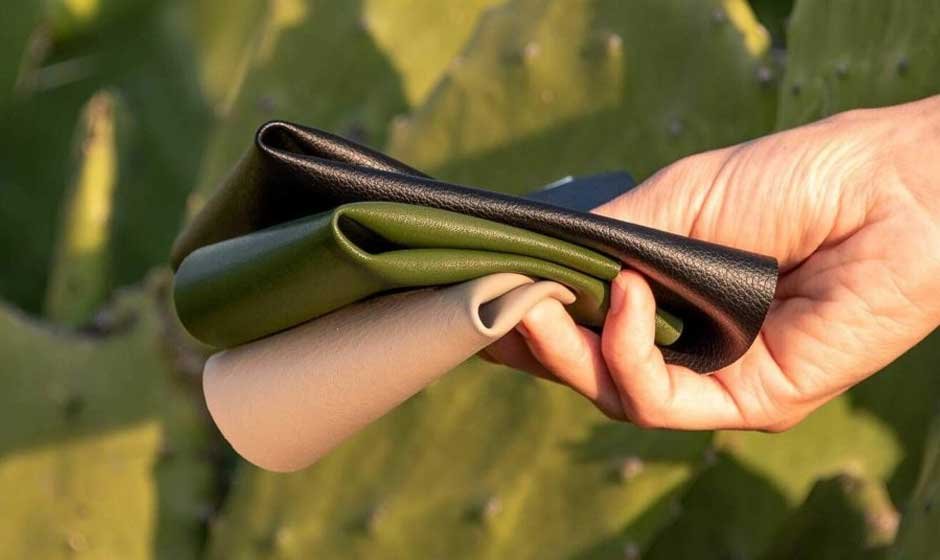Consumers today are becoming more and more aware of how their spending habits and what they purchase are affecting the environment. As a result of this, many consumers are turning to sustainable materials when shopping to reduce their personal environmental impact. Something is considered a sustainable material if it was manufactured considering how it can be used or reused more productively through its entire lifecycle, as well as taking into account ethical concerns that could put consumers off a product. A well known material in this movement towards more sustainable products and consumption is vegan leather.
What is vegan leather?
Any material that mimics animal leather or any material made using animal hides is classed as being ‘vegan leather’. It does not refer to a single material, but is instead used as an umbrella term for a range of materials. These materials have diverse origins, with some being made from synthetic fibres or others using plant-based fibres, such as pineapple, mushrooms, cork, cactus and even apple peels.
Where is vegan leather used?
Vegan leather is most commonly seen in the fashion and accessories industry to replace animal leather in products such as handbags, purses and jackets. Vegan leather is considered as a more durable alternative in some cases as it does not require as much upkeep as normal leather and is more water resistant. This is useful in the production of vegan leather handbags, as they are better suited to withstand everyday wear and tear, while still looking like their animal hide counterparts. Advancements in the production of vegan leather have made it possible to use it for more demanding situations. For example, sports equipment such as rugby boots can now be made from vegan leather and are much lighter than animal leather shoes, making it easier to move faster around the pitch.
Why is vegan leather better for the environment?
Compared to animal leather, vegan leather consumes less resources in its production. It is estimated that the leather industry uses billions of litres of water annually, whereas plant based vegan leathers use far less water in their manufacturing process. The tanning process for animal leather also uses a lot of harsh chemicals that can pollute the soil if they are not disposed of correctly. Vegan leather does not require tanning at any point in production, meaning that there is no need for complex wastewater treatment to ensure that soil and nearby rivers are not contaminated. Plant based vegan leathers also have fewer carbon emissions as their production does not require as much energy or resources as conventional leather.
What are recent developments in vegan leather?
Animal leather can use thousands of litres of water to produce a single kilogram of leather, whereas vegan leather has evolved to use only a fraction of this. Plastic leather can produce up to seven or eight times fewer carbon emissions than animal leather, but there are many new innovations in vegan leather that are gradually making it more sustainable than before.Some of these innovations include:
Pineapple leather (Piñatex):
Pineapple leather is made with the fibres of pineapple leaves that have had the pectin removed to make them more flexible. It is considered more sustainable than other vegan leathers as many of the byproducts generated during production can be reused or composted. As it is made from the byproduct of an existing crop, it also does not require additional land or water.
Mushroom leather (Mylo):
Mushroom leather does not need much water or many chemicals during its production, and it is a close replica for the feeling of cow leather. Similarly to pineapple leather, it uses waste recycling during production as agricultural waste (such as sawdust) can be used as ‘food’ for the fungus to develop.
Apple leather:
Apple leather is made from the waste left behind when apples are pressed for their juice. It is a sustainable material as the waste produced in juicing would otherwise be sent to landfill or burnt for fuel. It has similar properties to conventional leather as it is strong and long lasting, while remaining flexible and lightweight.
What are the other considerations of vegan leather?
Beyond the environmental impact of vegan leather, it is also considered a more ethical alternative to animal leather. This makes it an attractive material to consumers who are looking for cruelty free alternatives to leather, or for those following a vegan lifestyle. As both of these views are increasing in popularity among consumers alongside environmental concerns, vegan leather is encouraging more research into new, sustainable materials and is part of the larger movement towards more responsible manufacturing. Plant based alternatives are rapidly improving to satisfy the needs of consumers who seek plastic-free products, and plastic vegan leather is cheaper to produce making it more affordable for people on a budget. Designer brands, including Stella McCartney, are committed to not using animal materials like leather, and this can motivate other designers or smaller businesses to invest in vegan leather products.
In conclusion, vegan leather is a great sustainable alternative to animal leather that can reduce the environmental impact of the fashion industry and meet the demands of more conscious consumers. Compared to animal leather, vegan leather uses less water and almost no harmful chemicals in its production, making it better for the environment as it does not contaminate waterways and the soil. It also has a much lower carbon footprint, as the leather industry is a large contributor to greenhouse gas emissions. Plant based vegan leather is pushing the boundaries even more, as it uses the waste products of crop and food production, as well as producing waste in its own production that can be reused or recycled instead of being sent to landfill.










